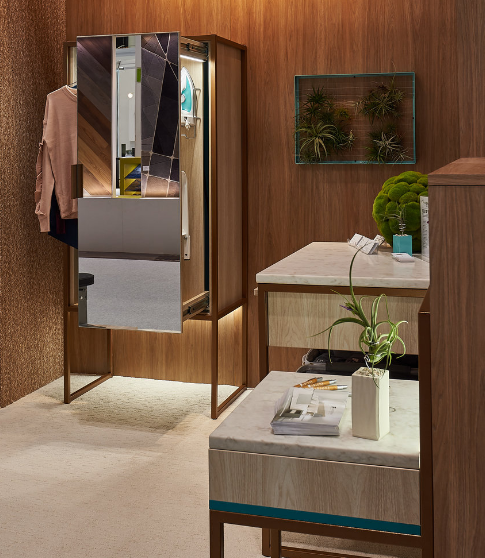
Consider this true story: A couple in their 60s booked a room at an upscale hotel operating under an internationally recognized brand. During their stay, the husband tried to set up his laptop on the desk. He searched for an outlet, typically found in the desk lamp's base, but only found a USB port.
Unfortunately, his laptop’s power cord wasn’t compatible with USB charging. So, the hunt for electricity continued until he had to crawl under the desk to find an outlet.
What’s the takeaway? It’s not that hotel rooms should eliminate USB ports.
The real point is that guests shouldn’t have to struggle to find basic amenities. More importantly, thoughtful design and placement of a hotel’s FF&E (fixtures, furniture, and equipment) can solve these issues, making the best use of FF&E cost while improving the guest experience.
Don’t Let Hotel FF&E Trends Fool You
The latest design trends for hospitality casegoods don’t always align with function or the realities of providing a high-level guest experience.
For instance, taking a minimalist approach to guestroom design shouldn’t equate to drastically cutting en-suite amenities, such as desks and storage. Or while stark or bright colors may be all the rage elsewhere, in a guestroom they can make a guest feel uncomfortable.
In a sense, hotel FF&E trends are no different than the clothing styles premiered during fashion week in Milan – while the garments look cutting edge, many would never actually “work” in the real world as they lack function. Ultimately, people want clothes they can actually wear.
In hotel guestroom design, one theme that persists is creating a space that feels like a “home away from home.” While this may seem somewhat self-contradictory, it makes perfect sense – guests want a sense of place where they stay. That man searching for an outlet would likely not have experienced such frustration at home. What’s more, a USB port without any regular outlets would seem foreign even to people much younger than he.
But home away from home goes far beyond providing an easy way to charge devices. Rather, it has to do with coupling convenience with a feeling of warmth and comfort.
Most people’s homes are not dominated by hard surfaces and overwhelming colors. They tend to be textured like most living rooms rather than sterile like an operating room or glaringly colorful. A hotel guest room design that intends to draw from home should follow suit.
That brings us to the difference between investing in “trends” versus investing in “trendy.” Genuine hotel interior design trends are made to last, transcend multiple generations, and delight guests for years to come.
One more thing – be wary of the trendy, it can hit your bottom line hard. Pay attention to trends that aren’t an abrupt break from how people normally live. Keeping up with what’s trendy can get expensive as it requires frequent updating.
What Hotel FF&E Products Should You Invest In?
Hotel FF&E is a major investment for any hotel. But to get an ROI from your furnishings, it’s important to invest in the right pieces. Hotel casegoods that pay long-term dividends are carefully & thoughtfully designed through the lens of the best guest experience.
As we see it, hotel furniture design that goes beyond the upfront investment is:
-
Multifunctional
-
Optimized with technology
-
Respectful of guests’ expectations
-
Clean, but not sterile
1. Multifunctional
Multifunctional furniture – think a desk with storage space – is huge right now in hotel design. Hotel rooms are getting smaller, so furniture that serves several functions has real value.
2. Optimized With Technology
Hotel FF&E that integrates technology keeps people from crawling under desks. Anywhere that technology can be added to a piece of hotel guest room furniture to improve its function is a win.
Certainly, USB ports are a must, but don’t forget things like guest-controlled ambient lighting elements or Bluetooth speaker technology. Smart headboards are a perfect example of technology taking a traditional casegood to the next level.
3. Respectful of Guest Expectations
Timeless finishes and colors make people feel at home. It might be best to use this year’s trendy colors and finishes sparingly and make sure the classics find their place.
4. Clean, but not Sterile
Sterile is not just clean. It’s, well, sterile. And most people don’t want to live in a cleanroom, nor do they want to stay in one. However, now more than ever, guests do expect a high level of cleanliness in their rooms. Don’t be afraid of hospitality furniture casegoods made from laminates or wood veneers. Both materials are the next best thing to furnishings made from traditional hardwoods and are easy to keep clean. Chances are wood is everywhere in a guest’s own home.
The Top Hotel FF&E Trend to Watch
A good example of a trend that isn’t too disruptive is the move people are making toward living greener lifestyles. Many of these folks are trying to incorporate greener materials into their lives at home.
They appreciate it when the place they’re staying on a business trip or vacation tries to do the same.
Hotels that have furniture manufactured with sustainable materials – such as recycled or reused materials – should let their guests know about it. It’s a point of differentiation that’s becoming more important as guests become more aware of the benefits.
Frequently Asked Questions About Hotel FF&E CostsHere are some frequently asked questions we get about hotel FF&E costs. What Specific Metrics Should Hotels Use To Measure The Roi Of Their Ff&E Investments?Hotels can measure the ROI of their FF&E investments through several metrics, including the increase in guest satisfaction scores, occupancy rates, and average daily rates (ADR). Tracking the length of guest stays and the frequency of repeat bookings can also provide insights into how well the FF&E contributes to a positive guest experience. Additionally, analyzing operational costs associated with maintenance and upkeep of the furniture, fixtures, and equipment can help determine overall profitability. How Can Hotels Effectively Balance Trendy Design Elements With Functionality Without Incurring High Ff&E Costs?
Hotels can balance trendy design with functionality by selecting versatile furniture that serves multiple purposes, allowing them to keep costs down while still incorporating current styles. Investing in timeless pieces that complement trendy accents can also provide a fresh look without requiring complete overhauls. Collaborating with manufacturers who understand both trends and practical design can ensure that hotels get the most value from their investments while staying relevant. What Are The Potential Risks Associated With Investing In Trendy Ff&E Designs?
Investing in trendy FF&E designs can lead to several risks, such as quickly becoming outdated, which may require costly replacements sooner than anticipated. Additionally, trends that do not resonate with guests can result in poor customer feedback, negatively impacting occupancy rates and revenue. There's also the risk of compromising functionality for aesthetics, which may lead to guest dissatisfaction and a less favorable overall experience. |
Matching Hotel FF&E Cost With ROI
Like hotel owners and designers, hospitality contract furniture manufacturers follow the trends, too. The good ones can tell the difference between what’s a fad and what’s a longer-term trend. They’ve worked with enough hotels to know what works.
Work closely with your hospitality casegoods manufacturer – it could mean happier guests and a better bottom line.
Editor's Note: This blog post was originally published on October 18, 2018 and was recently updated to reflect industry trends.

